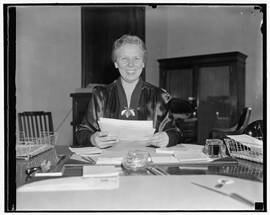The current issue of America magazine explores “Women in the Life of the Church” (PDF here), and the role of women in American politics is also getting new attention.
As already noted (“Mansplaining is exempt from government shutdown”), this month’s political brinkmanship was largely driven by men, whether they were bellicose (Ted Cruz) or aiming for a Gary Cooper–like taciturnity (no one could keep this up for long). The 20 women of the Senate, by contrast, got laudatory reviews for helping to put together a deal to reopen the federal government. (See Time magazine’s “Women Are the Only Adults Left in Washington,” in which Jay Newton-Small writes: “The notion that women in power function differently from men, more—collaboratively and thus more effectively, has long been an intuitively appealing but empirically unproven theory. Lately, the U.S. Senate has been running a lab test.”)
There may be some stereotyping here, but the Democratic Party in particular is counting on this positive image to help them win tough races in 2014. As Politico’s James Hohmann reports, the party is running strong women candidates for the U.S. Senate in three states that voted for Mitt Romney last year: AlisonLundergan Grimes in Kentucky, Michelle Nunn in Georgia, and Natalie Tennant in West Virginia. In Tennant’s case, the Democrats are trying outmatch a woman on the Republican side (Rep. Shelley Moore Capito). Grimes and Nunn will be well-financed in any case, but their odds will greatly improve if Tea Party candidates manage to upset incumbent Mitch McConnell in Kentucky and win an open GOP primary in Georgia. Then there are incumbent women Democrats in Louisiana (Mary Landrieu) and North Carolina (Kay Hagan). In most of the red states where they have the slightest chance of winning Senate races, the Democrats will be counting on women candidates to pull in voters who wouldn’t support Barack Obama for president.
It could be a smart move. Women have had notable successes in “enemy” territory, even as voters have been more likely to pick presidents and senators from the same party. In the 2012 Senate elections, Democrat Heidi Heitkamp scored the biggest surprise by narrowly winning a seat in North Dakota, which Romney won by 19 points. (Nate Silver had given the Republican a 92 percent chance of winning, notes Slate’s Daniel Engber.) Women have also been elected against their state’s partisan grain in Maine (Republican Susan Collins), Missouri (Democrat Claire McCaskill), and New Hampshire (Republican Kelly Ayoette), and in Alaska, Lisa Murkowski was re-elected as an independent after she lost her renomination bid in the GOP primary to a Tea Party candidate.
As for gubernatorial races, Wendy Davis is considered a long shot to win next year in Republican Texas. Still, she’ll probably raise more money than any male Democrat could, and in the past decade, Democrats have won in the Republican states of Arizona (Janet Napolitano) and Kansas (Kathleen Sebelius), while GOP women won in deeply blue Connecticut (Jodi Rell) and Hawaii (Linda Lingle).
The Monkey Cage’s Danny Hayes isn’t high on Davis’s chances, but he writes that her willingness to run in an adverse environment may encourage more women candidates across the United States. Contrary to the belief that sexism accounts for the low percentage of women in high offices, Hayes points to recent studies showing that voters and journalists do not regard women candidates differently from men, even when such candidates “act tough, get angry, shed tears, or commit gaffes.” He concludes:
[T]he emerging research suggests that the main reason that there aren’t more women in elective office is simply because they’re not running (something both Democratic and Republican strategists are trying to change). As research […] has found, women are less likely to view themselves as qualified to run and to be encouraged or recruited to run.
That’s why Davis’s candidacy is noteworthy. Women aren’t going to win most of these long-shot races (Grimes is not likely to beat McConnell in Kentucky, despite her homespun videos), but politics is a game of odds, and there will be more women office-holders only when there are a lot more women who take on difficult races. And if they do prove to have a special knack for winning votes from across the partisan divide, their influence on Capitol Hill will grow far beyond what we saw earlier this month.
Photo of Gladys Pyle (R-South Dakota), the first woman to be elected to the U.S. Senate without being appointed first, from the Library of Congress, published at the U.S. Senate website. Pyle served for two months in 1938, following a special election to temporarily fill a vacant seat.








